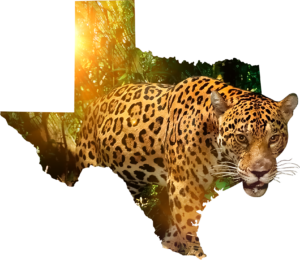
Jaguars in Texas? The Forgotten History and Wild Future of America’s Apex Predator
In the dense brushlands of South Texas, among the thorny
The journey to the discovery of Tlalocohyla celeste within the lush confines of Costa Rica’s Tapir Valley Nature Reserve is a tale of curiosity, perseverance, and scientific inquiry. Spearheaded by Donald Varela Soto, a local naturalist, and supported by biologist Valeria Aspinall, this endeavor highlights the critical role of local expertise and scientific collaboration in unveiling the mysteries of biodiversity. The detailed diagnosis of Tlalocohyla celeste, with its unique vocal sac, transparent ventral skin, and striking coloration, underscores the species’ distinct place within its genus and amplifies our understanding of amphibian diversity. This discovery not only enriches the global taxonomy but also opens new avenues for research on amphibian evolution, ecology, and conservation.
Donald Varela-Soto, a visionary and co-founder of the Tapir Valley Nature Reserve, has been instrumental in the transformation of a former cattle ranch into a thriving ecosystem. His deep connection to the land and its myriad sounds led to the initial discovery of Tlalocohyla celeste, a species that had eluded scientists until now. Varela-Soto’s dedication to conservation and his intimate knowledge of the reserve’s ecology were crucial in uncovering this hidden gem of biodiversity.
Valeria Aspinall, a biologist and a pivotal figure in the research team, brought her scientific expertise and passion for conservation to the forefront of this discovery. Her meticulous observations and analyses were instrumental in documenting the new species’ unique characteristics and behaviors. Aspinall’s role extended beyond the realms of academic research; she actively engaged in the conservation efforts that provided the foundation for the frog’s habitat. Her collaboration with Varela-Soto exemplifies the synergy between scientific inquiry and conservation, a partnership that yields results far greater than the sum of its parts.
The reserve’s transformation from pastureland to a biodiverse sanctuary was significantly supported by conservation organizations.
A critical aspect of conserving Tlalocohyla celeste and its habitat has been the innovative management of ecotourism’s ecological impact. With financial support from Grow Jungles, the reserve has constructed floating bridges across the wetlands, allowing visitors to immerse themselves in the reserve’s natural beauty without contributing to chemical runoff into the ecosystem. Constructing floating bridges in the wetlands have been pivotal in mitigating the ecological impact of visitors, reducing potential chemical runoff into the waterways—a threat to the delicate ecosystem supporting Tlalocohyla celeste.
The collaborative effort between the reserve’s stewards and conservation groups underscores a broader narrative of ecological restoration and sustainable coexistence between humans and wildlife. The Tapir Valley Nature Reserve serves as a living laboratory, showcasing the successful regeneration of forest ecosystems and the emergence of new species like Tlalocohyla celeste.
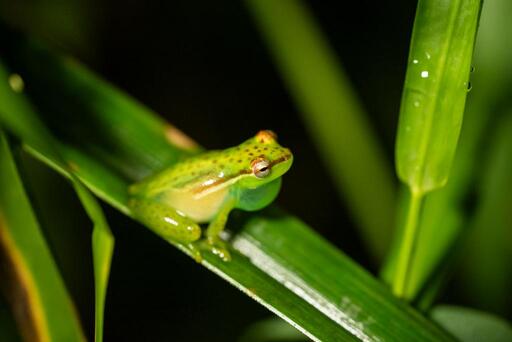
To enrich our understanding of the newly discovered Tapir Valley tree frog, Tlalocohyla celeste, it is essential to delve into the scientific data that distinguishes this species from its congeners and underscores its unique place within the ecosystem of the Tapir Valley Nature Reserve. The frog’s discovery not only contributes to the biodiversity records of Costa Rica but also offers valuable insights into the ecological dynamics and evolutionary processes that shape amphibian life in tropical rainforests.
Morphological Characteristics: Tlalocohyla celeste is characterized by its diminutive size, with adult males measuring approximately 21 mm in snout-vent length (SVL) and females slightly larger at about 24 mm SVL. This size distinction makes it one of the smallest members within the Hylidae family identified in Costa Rica. The absence of a tympanic membrane, a developed vocal sac extending to the pectoral region, and the lack of vomerine teeth are among its defining morphological traits. Additionally, its dorsal coloration, a vibrant yellow-green, sets it apart from other species, complemented by a unique pattern of coloration and markings, including a distinct incomplete sulfur white dorsolateral stripe bordered by a diffuse mahogany red stripe.
Bioacoustic Properties: The vocal repertoire of Tlalocohyla celeste is notably diverse, with at least three distinct call types identified. These calls range from trills and squeaks to croaks, each with specific frequencies and patterns that facilitate identification and communication among individuals. This bioacoustic diversity not only aids in mating and territorial disputes but also provides insights into the species’ evolutionary adaptations to its environment.
Habitat and Ecology: Tlalocohyla celeste is endemic to a specific wetland habitat within the Tapir Valley Nature Reserve, highlighting its highly specialized habitat requirements. The wetland’s unique conditions, including water chemistry, vegetation type, and microclimate, play a crucial role in the frog’s lifecycle and reproductive strategies. Observations indicate that Tlalocohyla celeste employs a unique reproductive mode, with eggs deposited on leaves above water, suggesting a complex interaction with its environment that necessitates further study.
Conservation Status: Given its limited range, confined to an 8-hectare wetland, and specialized habitat needs, Tlalocohyla celeste is considered critically endangered. Its survival is intricately linked to the conservation of its wetland habitat, underscoring the importance of ongoing conservation efforts within the Tapir Valley Nature Reserve. The species’ vulnerability to habitat alteration, pollution, and climate change highlights the urgent need for targeted conservation strategies to ensure its long-term survival.
Phylogenetic Analysis: Preliminary genetic studies suggest that Tlalocohyla celeste is closely related to other members of the Tlalocohyla genus, yet distinct enough to warrant its classification as a new species. These analyses provide a framework for understanding the evolutionary history of the genus and the ecological niches that Tlalocohyla celeste and its relatives occupy.
In conclusion, the story of Tlalocohyla celeste is not just about the discovery of a new species; it’s a narrative about human impact, the power of conservation, and the endless mysteries that nature holds. It reminds us of our responsibility to protect these fragile ecosystems and the life they support, ensuring that the chorus of the Tapir Valley tree frog continues to echo through the forests of Costa Rica for generations to come.
The scientific data surrounding Tlalocohyla celeste not only enriches our understanding of this newly discovered species but also highlights the complexity of tropical ecosystems and the intricate relationships between species and their environments. The conservation of Tlalocohyla celeste and its habitat within the Tapir Valley Nature Reserve represents a critical step in preserving the biodiversity and ecological integrity of this unique ecosystem. Further research and monitoring are essential to uncover the full extent of the species’ biology, ecology, and conservation needs, providing a foundation for effective conservation strategies and enhancing our understanding of tropical amphibian diversity. The discovery of Tlalocohyla celeste is a testament to the resilience of nature and the profound impact of dedicated conservation work. This tiny frog serves as a symbol of the biodiversity that can thrive when given a chance through thoughtful, directed restoration efforts. Moreover, it highlights the critical need for continued research and protection of Costa Rica’s unique ecosystems, which harbor unknown numbers of yet-to-be-discovered species.
As we celebrate the discovery of Tlalocohyla celeste and reflect on the transformative journey of Tapir Valley from a cattle ranch to a vibrant conservation oasis, we extend our heartfelt gratitude to the remarkable entities and individuals who have made this possible. Their dedication, passion, and relentless pursuit of conservation and scientific exploration have not only enriched our understanding of biodiversity but also set a benchmark for conservation efforts worldwide.
Costa Rica Wildlife Foundation (CRWF)
To the Costa Rica Wildlife Foundation, we express our profound appreciation for your unwavering commitment to preserving Costa Rica’s natural heritage. Your support in facilitating crucial research, conservation projects, and community engagement initiatives has been instrumental in safeguarding the country’s biodiversity. Your efforts serve as a beacon of hope, inspiring collective action towards environmental stewardship.
Tapir Valley Nature Reserve
To the Tapir Valley Nature Reserve, we extend our deepest thanks for serving as a sanctuary for wildlife and a living laboratory for conservation practices. Your transformation from pastoral lands to a biodiversity hotspot exemplifies the power of rewilding and habitat restoration. Through your dedication, you have created a haven not only for Tlalocohyla celeste but for countless other species, showcasing the beauty and resilience of nature when given a chance to thrive.
Donald Varela Soto
To Donald Varela Soto, your passion and perseverance in the face of nature’s mysteries are truly inspiring. Your curiosity and dedication led to the discovery of Tlalocohyla celeste, highlighting the importance of local knowledge and expertise in scientific discovery. Your vision for Tapir Valley and your commitment to conservation have played a pivotal role in protecting this precious slice of Costa Rica’s biodiversity.
Valeria Aspinall
To Valeria Aspinall, your expertise, leadership, and dedication to the Tlaloc Conservation program have been crucial in the ongoing efforts to understand and protect Tlalocohyla celeste and other threatened amphibians. Your work embodies the spirit of conservation, combining scientific rigor with a deep respect for nature. Your contributions have not only advanced our knowledge but also fostered a culture of conservation that extends beyond borders.
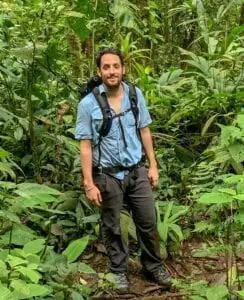
Founder of Grow Jungles

In the dense brushlands of South Texas, among the thorny
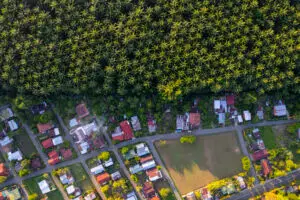
In a world increasingly driven by environmental consciousness, few things
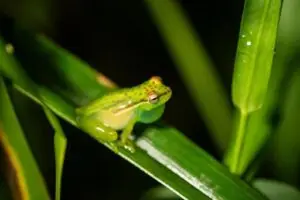
https://youtu.be/GjQ0pc5C5To?si=0fOw9htuS4Ay05Qm The journey to the discovery of Tlalocohyla celeste within